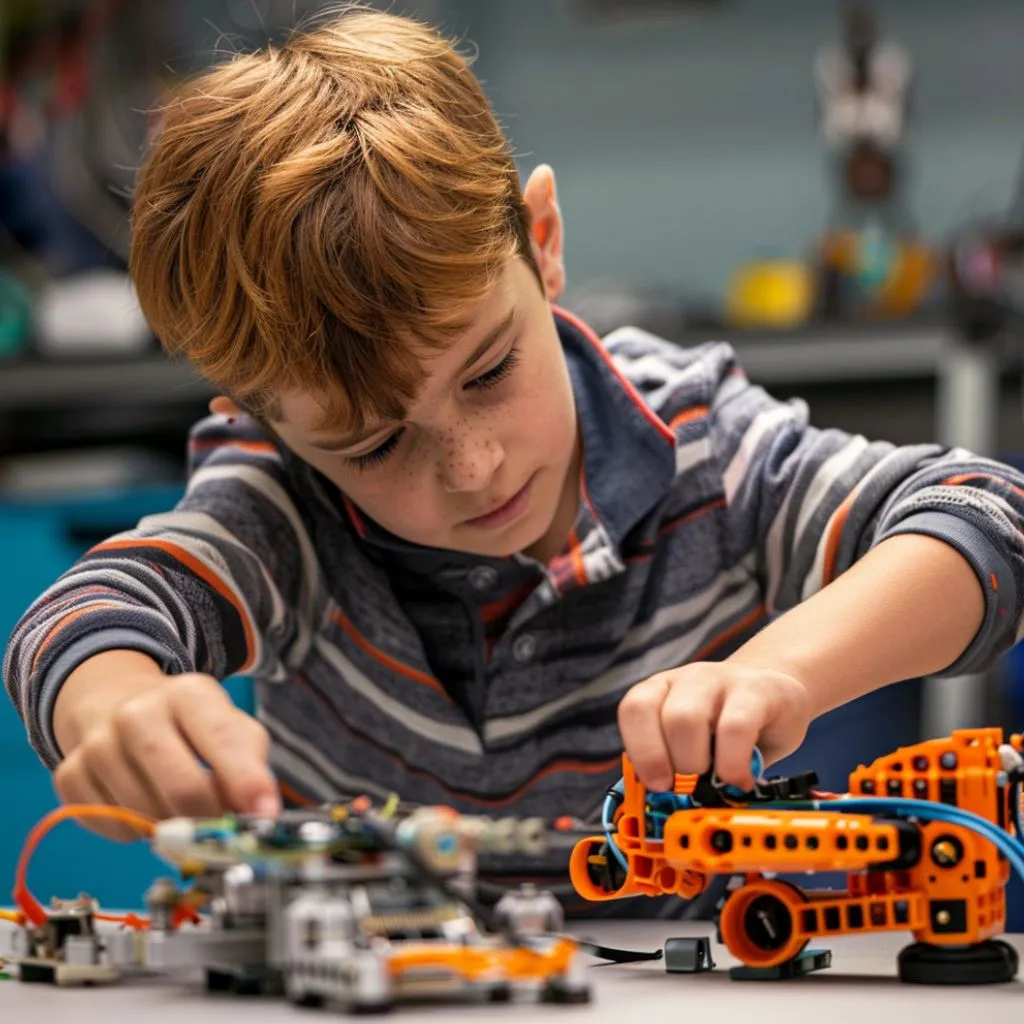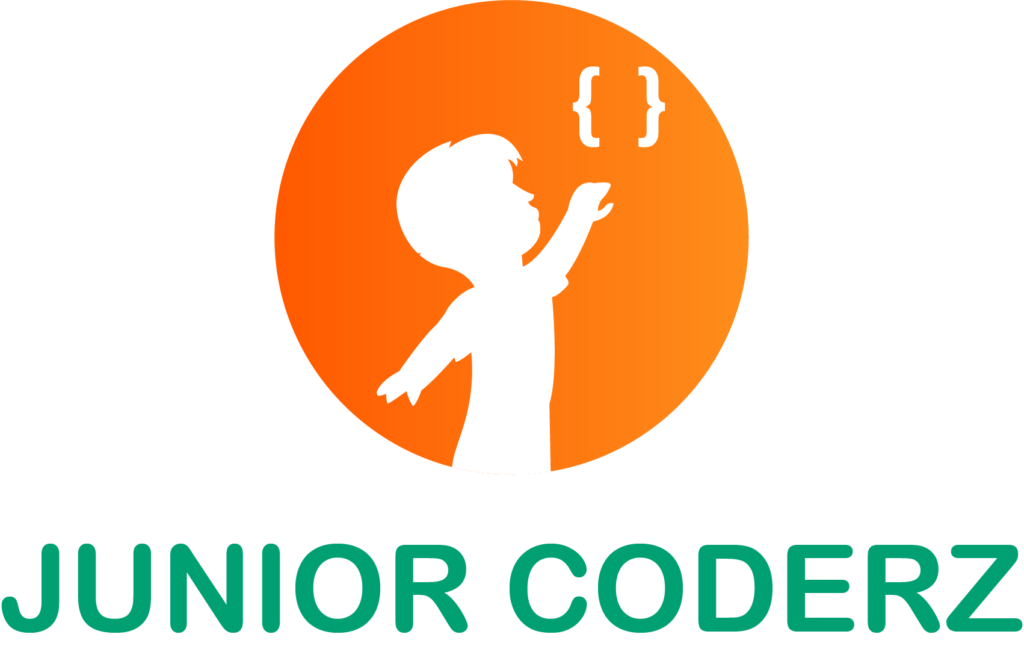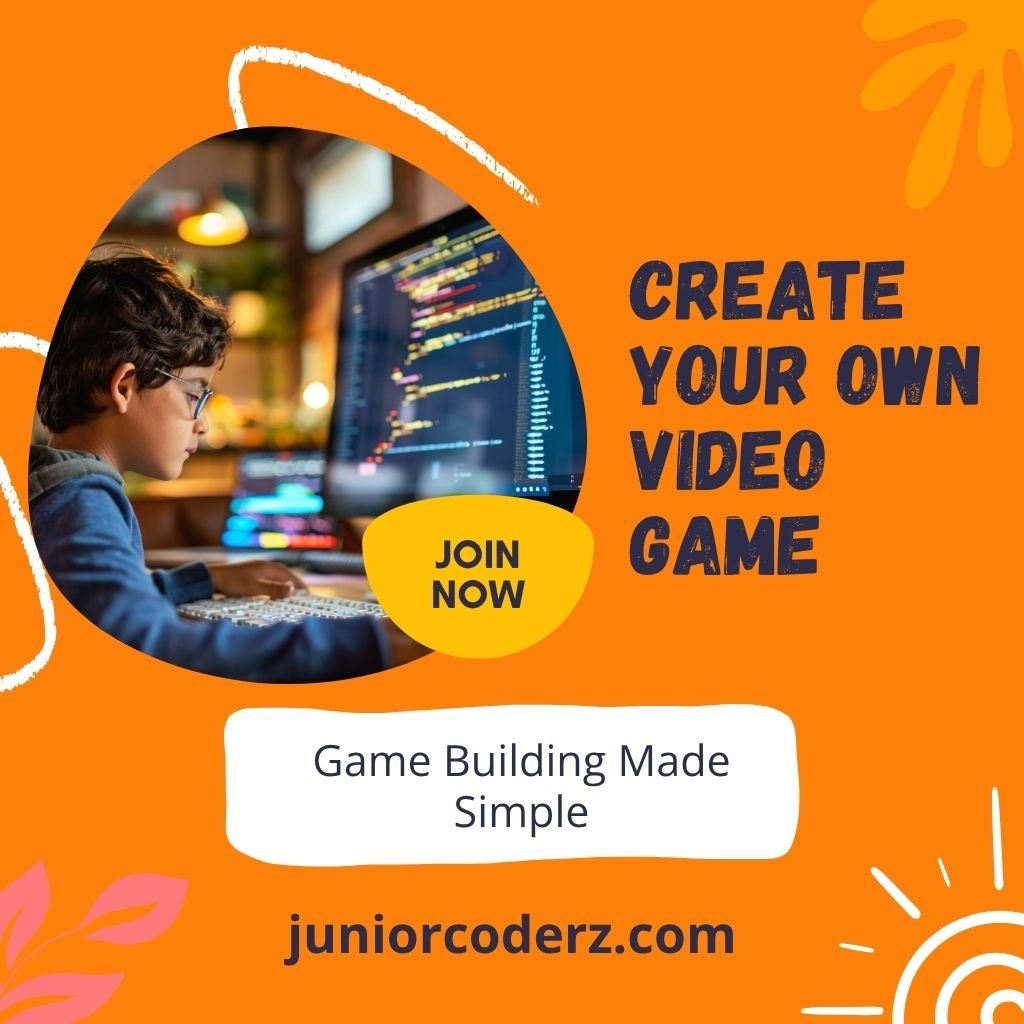In today’s digital age, kids aren’t just playing video games—they’re building them! If your child is passionate about gaming, why not guide them into the exciting world of game creation? Learning how to create a video game is no longer reserved for tech experts. With the right tools, mindset, and guidance, children as young as 7 can dive into game design for kids and build their own virtual worlds from scratch.
But what does it really take to create your own computer game? What are the exact steps, and how can you ensure the process is both fun and educational? In this blog, we’re peeling back the curtain on the tools, platforms and secrets young developers use to go from imagination to playable reality. Whether you’re a curious parent or an inspired young coder, what you’re about to learn may surprise you. Ready to spark your creativity and start your game design journey?
Let’s get started—and discover how kids can turn screen time into creation time!
Why Kids Should Learn Game Development?
Game development isn’t just about making fun digital experiences—it’s a multidisciplinary activity that nurtures a wide range of life and career-ready skills in children.
1. Critical Thinking & Problem-Solving:
When designing a game, kids constantly encounter challenges—like how to make a character jump or how to design a level that is fun but not too hard. Solving these challenges boosts logical reasoning and analytical thinking. They learn to break problems down, test solutions, and adapt strategies—an essential 21st-century skill.
2. Creativity & Storytelling:
Creating a game is an outlet for imagination. Whether it’s inventing a new world, writing character dialogue, or designing puzzles, kids explore storytelling in a hands-on way. It enhances their ability to craft narratives and express themselves in digital formats.
3. Logical Reasoning & Coding Literacy:
Game development introduces coding in a playful context. Even drag-and-drop tools like Scratch teach the fundamentals of logic, sequences, loops, and conditions—concepts at the heart of all programming languages. It helps kids build computational thinking in a natural, enjoyable way.
4. Confidence & Ownership:
Finishing a playable game gives children a sense of achievement. They’re creating something others can enjoy, and that builds pride and self-esteem. From debugging issues to completing a project, each step reinforces perseverance and independence.
In short, learning how to create a video game transforms kids into empowered creators instead of passive screen users. It’s an educational path that’s as fun as it is formative.
Step 1: Understanding the Basics of Game Design for Kids

Before diving into coding, it’s essential for kids to grasp the fundamental concepts of game design. These basics help turn random ideas into a clear, playable structure. Game design is not just about making a game fun; it’s about shaping how players interact with the story, mechanics, and goals.
1. Concept creation:
This is the heart of your game. Kids should ask: What type of game do I want to create? Is it a puzzle that challenges the brain, a platformer with jumping and levels, or a story-driven adventure game? This step helps define the game’s genre and overall direction.
2. Character and story development:
Every engaging game has memorable characters and a goal. Who is the hero? What is their mission? What challenges or villains do they face? Storytelling adds emotional connection and motivation.
3. Game mechanics:
These are the rules and systems that make the game function. How does the player move? How do they earn points or complete levels? Mechanics determine how enjoyable and challenging the gameplay will be.
4. User interface (UI):
Kids should consider how players will control the game. What buttons will be used? Are there health bars, menus, or inventory systems? A clear and intuitive UI makes the game easy to play and understand.
Understanding these core components early allows kids to design with purpose. It brings structure to their creativity and lays a solid foundation for the development process that follows.
Step 2: Choosing the Right Game Development Tools
When it comes to learning how to create a video game, selecting the right tools makes all the difference. Here are the essential tools every young game developer should know about:
1. Scratch:
Scratch is the go-to tool for beginners. Designed by MIT, it uses a drag-and-drop interface with colorful blocks to help kids understand coding logic and game flow without writing code. It’s perfect for building fun, interactive stories and simple games.
2. Tynker:
This tool offers both block-based and text-based programming. It’s structured to grow with your child, starting with visual coding and progressing to real programming languages like Python and JavaScript. Tynker is excellent for building various game types with its project-based learning approach.
3. Construct 3:
A powerful yet user-friendly game engine, Construct 3 allows kids to design 2D games with a visual interface. It supports advanced logic, animations, and physics, which makes it ideal for those who want to dive deeper into more technical aspects of game creation.
4. Unity with Bolt:
Unity is a professional-grade engine used in the gaming industry. With Bolt—a visual scripting tool—kids can begin developing 3D games without learning complex code initially. As their skills grow, they can transition to using C# to unlock Unity’s full potential.
At Junior Coderz, we teach kids how to use these tools step by step through guided, engaging, and age-appropriate lessons. Our programs are built to empower every child to turn their gaming passion into real-world creation. Whether it’s a beginner project on Scratch or a more advanced 3D game in Unity, we’re here to support your child’s journey.
Step 3: Learning the Steps to Know How to Create Video Game
Learn how to create a video game is a structured and rewarding process that introduces kids to the full cycle of software development. Even the simplest games follow a series of essential steps that build technical skills and nurture creativity.
1.Brainstorm the concept:
This is the imagination stage. Kids decide on the game type (platformer, puzzle, adventure, etc.), the theme, and main objective. For example, will the player collect coins, solve puzzles, or defeat a villain?
2. Design the game:
Here, the child maps out the structure of the game. This includes sketching characters, designing levels, creating storyboards, and deciding the layout of controls and menus. The clearer the plan, the smoother the development.
3. Develop the game:
Using tools like Scratch, Construct 3, or Unity, kids begin to build the game. They animate characters, define interactions, set rules, and connect game elements through logic or code blocks.
4. Test the game:
Testing is about identifying bugs and ensuring the game plays as expected. Kids will run through each level, check all controls, and verify outcomes (like scorekeeping and collisions) work correctly.
5. Refine the game:
After testing, improvements are made. This includes adding sound effects, adjusting difficulty, improving graphics, or enhancing storytelling to make the experience more polished and fun.
6. Share the game:
Once complete, it’s time to publish! Games can be shared on platforms like Scratch or exported as playable files. This final step gives kids a sense of accomplishment and opens the door for feedback and encouragement.
By following these steps for how to create a video game, kids not only learn how to build their own games—they gain valuable lessons in organization, creativity, debugging, and perseverance. It’s a powerful blend of fun and education that builds real-world skills.
Step 4: Incorporating Visuals and Audio
Visuals and audio are what transform a basic game into an immersive experience. They provide mood, atmosphere, and personality. Teaching children how to design and implement these elements helps expand their artistic and technical skills.
1.Character Sprites and Backgrounds:
Using free tools like Piskel, kids can design pixel art characters, enemies, and backgrounds. This introduces them to concepts like resolution, animation frames, and color palettes.
2. User Interface (UI) Elements:
Visual design also includes buttons, score counters, health bars, and inventory icons. These elements are essential to making the game navigable and player-friendly.
3. Sound Effects and Music:
Audio sets the tone. Kids can source royalty-free soundtracks from websites like Freesound.org or Incompetech.com to add background music or effects like jumps, hits, and game-over sounds. Recording their own effects or voice overs can add a unique, personal flair.
4. Synchronization and Timing:
They also learn how to time audio to actions—like a jump sound that plays exactly when a character leaps—developing a sense of event coordination.
By integrating these creative elements, kids enhance storytelling, evoke emotions, and make their games more engaging and memorable. These skills are fundamental to video game design for kids, fostering a balance of logic, creativity, and user-focused design.
Step 5: Testing and Getting Feedback
Testing is a vital phase in game development where kids learn to evaluate their work objectively and improve it based on user experience. It teaches them how to spot mistakes, solve problems, and empathize with their audience—skills that are crucial beyond gaming.
1.Invite test players:
Ask friends, siblings, or parents to play the game. Watching others interact with the game helps identify pain points that may not be obvious to the creator.
2. Observe behavior closely:
See where players get confused, lose interest, or ask questions. These moments indicate opportunities to improve instructions, balance difficulty, or clarify game mechanics.
3. Collect specific feedback:
Encourage testers to share what they liked, what confused them, and what they think could be better. Use this input to make targeted refinements.
4. Create a feedback loop:
Kids can implement changes and then test again. This reinforces iterative thinking and builds the habit of continuous improvement.
Testing isn’t just bug-fixing; it’s an exercise in communication, design thinking, and resilience. Learning how to receive and apply feedback prepares kids to be thoughtful creators in any field.
Step 6: Publishing and Celebrating the Game
Once your child has built and refined their game, it’s time to publish it and share it with the world. This final step in the game development process gives kids the opportunity to showcase their creativity, receive recognition, and gain a sense of real accomplishment.
1.Scratch or Tynker Communities:
These platforms not only allow kids to build games but also have built-in communities where games can be published, viewed, and commented on by other young creators. This creates a positive environment for feedback and learning.
2. Exporting to HTML5:
Many game development tools let kids export their games as HTML5 files, which can be uploaded to a personal website or blog. This introduces them to web publishing and gives them a space they can customize and update.
3. itch.io and Similar Platforms:
itch.io is a free and open platform for indie developers to share their games. With guidance from parents, kids can upload their creations here to gain exposure, collect comments, and even track downloads and engagement.
4. Creating a Game Portfolio:
Encourage your child to document each game they create, including the concept, tools used, screenshots, and lessons learned. Over time, this builds a portfolio they can be proud of and refer back to as they continue to improve.
Publishing isn’t just about sharing—it’s about celebrating. Completing and showcasing a game is a powerful boost to a child’s confidence and a testament to their persistence, imagination, and skill.
Tips for Parents to Support Their Child’s Game Development Journey
Parents play a crucial role in their child’s success in learning game development. Encouragement, structure, and active involvement can make the difference between a fleeting interest and a lasting passion. Here’s how parents can provide meaningful support:
1. Foster creative freedom:
Allow your child to explore ideas, even if their game doesn’t follow traditional logic or storylines. It’s more important that they experiment and express themselves than build a “perfect” game.
2. Set balanced screen time:
While coding and designing require screen time, ensure it’s used constructively. Set boundaries so your child has time to reflect, plan, and take breaks—which are just as valuable as development time.
3. Celebrate every milestone:
Whether it’s fixing a small bug or finishing their first level, acknowledge their achievements. Positive reinforcement builds motivation and confidence.
4. Be an engaged player:
Show genuine interest in their games. Playtest them, give feedback, and ask questions about their design choices. This not only validates their efforts but also sharpens their ability to explain and improve their work.
5. Help them stay organized:
Encourage them to keep a development journal, track versions of their game, or create a to-do list. Organization enhances productivity and helps them see their progress over time.
Parental support turns learning into bonding. By being present and proactive, you’re not only helping your child learn a new skill—you’re nurturing a creative mindset that will benefit them for life.
The Bigger Picture: From Games to Future Careers
Kids who learn game development today gain skills for tomorrow:
- Programming and software engineering
- Game design and animation
- Storyboarding and creative writing
- Entrepreneurship and digital marketing
The journey of learning how to create your own computer game could be the first step toward a future career.
Conclusion: Let the Adventure Begin!
Game development opens up a world of opportunity for kids. It’s fun, educational, and empowering. Whether they want to build the next Minecraft or just explore creative storytelling, the tools are right at their fingertips.
Start with a simple idea. Use beginner-friendly tools. Follow the steps to learn how to create a video game. And most of all—let your child’s imagination lead the way.
Ready to Help Your Child Create Their First Game?
Junior Coderz offers beginner-friendly, project-based classes on game development. Enroll now to ignite your child’s love for coding!
FAQs
Q. What is the best age for kids to start learning game development?
Kids as young as 7 can start with platforms like Scratch. As they grow, they can explore more complex tools.
Q. What tools do kids need to create their own video game?
Scratch, Tynker, Gamefroot, and Construct 3 are great beginner tools. Unity is ideal for more advanced learners.
Q. Is programming knowledge required before creating a game?
No. Many platforms offer drag-and-drop interfaces that teach logic without syntax.
Q. How long does it take to build a simple game?
With proper guidance, a basic game can be created in a few hours.
Q. Does Junior Coderz offer game development classes for kids?
Yes! We offer engaging online courses for all skill levels. Visit Junior Coderz.com to learn more.

